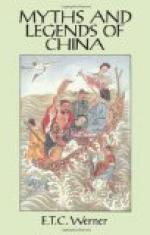the creation may be admitted; but, as will presently
be seen, it is over-stating the case to say that he
was conceived with the set purpose of furnishing the
ordinary mind with a concrete solution or illustration
of this great problem. There is no evidence that
P’an Ku had existed as a tradition before the
time when we meet with the written account of him;
and, what is more, there is no evidence that there
existed any demand on the part of the popular mind
for any such solution or illustration. The ordinary
mind would seem to have been either indifferent to
or satisfied with the abstruse cosmogonical and cosmological
theories of the early sages for at least a thousand
years. The cosmogonies of the
I ching,
of Lao Tzu, Confucius (such as it was), Kuan Tzu, Mencius,
Chuang Tzu, were impersonal. P’an Ku and
his myth must be regarded rather as an accident than
as a creation resulting from any sudden flow of psychological
forces or wind of discontent ruffling the placid Chinese
mind. If the Chinese brought with them from Babylon
or anywhere else the elements of a cosmogony, whether
of a more or less abstruse scientific nature or a
personal mythological narrative, it must have been
subsequently forgotten or at least has not survived
in China. But for Ko Hung’s eccentricity
and his wish to experiment with cinnabar from Cochin-China
in order to find the elixir of life, P’an Ku
would probably never have been invented, and the Chinese
mind would have been content to go on ignoring the
problem or would have quietly acquiesced in the abstract
philosophical explanations of the learned which it
did not understand. Chinese cosmogony would then
have consisted exclusively of the recondite impersonal
metaphysics which the Chinese mind had entertained
or been fed on for the nine hundred or more years
preceding the invention of the P’an Ku myth.
Nue Kua Shih, the Repairer of the Heavens
It is true that there exist one or two other explanations
of the origin of things which introduce a personal
creator. There is, for instance, the legend—first
mentioned by Lieh Tzu (to whom we shall revert later)—which
represents Nue Kua Shih (also called Nue Wa and Nue
Hsi), said to have been the sister and successor of
Fu Hsi, the mythical sovereign whose reign is ascribed
to the years 2953-2838 B.C., as having been the creator
of human beings when the earth first emerged from
Chaos. She (or he, for the sex seems uncertain),
who had the “body of a serpent and head of an
ox” (or a human head and horns of an ox, according
to some writers), “moulded yellow earth and
made man.” Ssu-ma Cheng, of the eighth century
A.D., author of the Historical Records and
of another work on the three great legendary emperors,
Fu Hsi, Shen Nung, and Huang Ti, gives the following
account of her: “Fu Hsi was succeeded by
Nue Kua, who like him had the surname Feng. Nue
Kua had the body of a serpent and a human head, with




